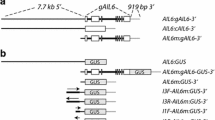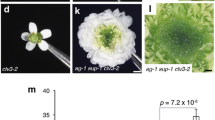Abstract
The Arabidopsis floral homeotic gene AGAMOUS (AG) is a regulator of early flower development. The ag mutant phenotypes suggest that AG has two functions in flower development: (1) specifying the identity of stamens and carpels, and (2) controlling floral meristem determinacy. To dissect these two AG functions, we have generated transgenic Arabidopsis plants carrying an antisense AG construct. We found that all of the transgenic plants produced abnormal flowers, which can be classified into three types. Type I transgenic flowers are phenocopies of the ag-1 mutant flowers, with both floral meristem indeterminacy and floral organ conversion; type II flowers are indeterminate and have partial conversion of the reproductive organs; and type III flowers have normal stamens and carpels, but still have an indeterminate floral meristem inside the fourth whorl of fused carpels. The existence of type III flowers indicates that AG function can be perturbed to affect only floral meristem determinacy, but not floral organ identity. Furthermore, the fact that floral meristem determinacy is affected in all transformants, but floral organ identity only in a subset of them, suggests that the former may required a higher level of AG activity than the latter. This hypothesis is supported by the levels of AG'mRNA detected in different transformants with different frequencies of distinct types of abnormal antisense AG transgenic flowers. Finally, since AG inhibits the expression of another floral regulatory gene AP1, we examined AP1 expression in antisense AG flowers, and found that AP1 is expressed at a relatively high level in the center of type II flowers, but very little or below detectable levels in the inner whorls of type III flowers. These results provide further insights into the interaction of AG and AP1 and how such an interaction may control both organ identity and floral meristem determinacy.
Similar content being viewed by others
References
Alvarez J, Guli CL, Yu X-H, Smyth DR: terminal flower: a gene affecting inflorescence development in Arabidopsis thaliana. Plant J 2: 103–116 (1992).
Bowman JL, Alvarez J, Weigel D, Meyerowitz EM, Smyth DR: Control of flower development in Arabidopsis thaliana by APETALA1 and interacting genes. Development 119: 721–743 (1993).
Bowman JL, Drews GN, Meyerowitz EM: Expression of the Arabidopsis floral homeotic gene AGAMOUS is restricted to specific cell types late in flower development. Plant Cell 3: 749–758 (1991).
Bowman JL, Sakai H, Jack T, Weigel D, Mayer U, Meyerowitz EM: SUPERMAN, a regulator of floral homeotic genes in Arabidopsis. Development 114: 599–615 (1992).
Bowman JL, Smyth DR, Meyerowitz EM: Genes directing flower development in Arabidopsis. Plant Cell 1: 37–52 (1989).
Bowman JL, Smyth DR, Meyerowitz EM: Genetic interactions among floral homeotic genes of Arabidopsis. Development 112: 1–20 (1991).
Clark SE, Running MP, Meyerowitz EM: CLAVATA1, a regulator of meristem and floral development in Arabidopsis. Development 119: 397–418 (1993).
Coen ES, Meyerowitz EM: The war of the whorls: genetic interactions controlling flower development. Nature 353: 31–37 (1991).
Drews GN, Bowman JL, Meyerowitz EM: Negative regulation of the Arabidopsis homeotic gene AGAMOUS by the APETALA2 product. Cell 65: 991–1002 (1991).
Goto K, Meyerowitz E: Function and regulation of the Arabidopsis floral homeotic gene PISTILLATA. Genes Devel 8: 1548–1560 (1994).
Gustafson-Brown C, Savidge B, Yanofsky MF: Regulation of the Arabidopsis floral homeotic gene APETALA1. Cell 76: 131–143 (1994).
Hensel LL, Nelson MA, Richmond TA, Bleecker AB: The fate of inflorescence meristem is controlled by developing fruits in Arabidopsis. Plant Physiol 106: 863–876: (1994).
Herskowitz I: A regulatory hierarchy for cell specialization in yeast. Nature 342: 749–757 (1990).
Hill JP, Lord EM: Floral development in Arabidopsis thaliana: a comparison of the wild type and the homeotic pistillata mutant. Can J Bot 67: 2922–2936 (1989).
Huala E, Sussex IM: LEAFY interacts with floral homeotic genes to regulate Arabidopsis floral development. Plant Cell 4: 901–913 (1992).
Huang H, Ma H: An improved procedure for transforming Arabidopsis thaliana (Landsberg erecta) root explants. Plant Mol Biol Rep 10: 372–383 (1992).
Huang H, Mizukami Y, Hu Y, Ma H: Isolation and characterization of the binding sequences for the product of the Arabidopsis floral homeotic gene AGAMOUS. Nucl Acids Res 21: 4769–4776 (1993).
Irish VF, Sussex IM: Function of the apetala-1 gene during Arabidopsis floral development. Plant Cell 2: 741–753 (1990).
Jack T, Brockman LL, Meyerowitz EM: The homeotic gene APETALA3 of Arabidopsis thaliana encodes a MADS box and is expressed in petals and stamens. Cell 68: 683–697 (1992).
Jofuku KD, denBoer BGW, VanMontagu M, Okamuro JK: Control of Arabidopsis flower and seed development by the homeotic gene APETALA2. Plant Cell 6: 1121–1125 (1994).
Kempin SA, Mandel MA, Yanofsky MF: Conversion of perianth into reproductive organs by ectopic expression of the tobacco floral homeotic gene NAG1. Plant Physiol 103: 1041–1046 (1993).
Komaki MK, Okada K, Nishino E, Shimura Y: Isolation and characterization of novel mutants of Arabidopsis thaliana defective in flower development. Development 104: 195–203 (1988).
Kunst L, Klenz JE, Martinez-Zapater J, Haughn GW: AP2 gene determines the identity of perianth organs in flowers of Arabidopsis thaliana. Plant Cell 1: 1131–1135 (1989).
Ma H: The unfolding drama of flower development: recent results from genetic and molecular analyses. Genes Devel 8: 745–756 (1994).
Ma H, Yanofsky MF, Meyerowitz EM: AGL1-AGL6, an Arabidopsis gene family with similarity to floral homeotic and transcription factor genes. Genes Devel 5: 484–495 (1991).
Mandel MA, Gustafson-Brown C, Savidge B, Yanofsky MF: Molecular characterization of the Arabidopsis floral homeotic gene APETALA1. Nature 360: 273–277 (1992).
Maniatis T, Fritsch EF, Sambrook J: Molecular Cloning: A Laboratory Manual. Cold Spring Harbor Laboratory Press, Cold Spring Harbor (1982).
Manoukian AS, Krause HM: Concentration-dependent activities of the even-skipped protein in Drosophila embryos. Genes Devel 6: 1740–1751 (1992).
Mizukami Y, Ma H: Ectopic expression of the floral homeotic gene AGAMOUS in transgenic Arabidopsis plants alters floral organ identity. Cell 71: 119–131 (1992).
Norman C, Runswick M, Pollock R, Treisman R: Isolation and properties of cDNA clones encoding SRF, a transcription factor that binds to the c-fos serum response element. Cell 55: 989–1003 (1988).
Odell PW, Nagy F, Chua N-H: Identification of DNA sequences required for activity of the cauliflower mosaic virus 35S promoter. Nature 313: 810–812 (1985).
Okamuro JK, denBoer BGW, Jofuku KD: Regulation of Arabidopsis flower development. Plant Cell 5: 1183–1193 (1993).
Pnueli L, Hareven D, Rounsley SD, Yanofsky MF, Lifschitz E: Isolation of the tomato AGAMOUS gene TAG1 and analysis of its homeotic role in transgenic plants. Plant Cell 6: 163–173 (1994).
Rogers SG, Klee HJ, Horsch RB, Fraley RT: Improved vectors for plant transformation: expression cassette vectors and new selectable markers. Meth Enzymol 153: 253–277 (1987).
Schultz EA, Haughn GW: LEAFY, a homeotic gene that regulates inflorescence development in Arabidopsis. Plant Cell 3: 771–781 (1991).
Schultz EA, Haughn GW: Genetic analysis of the floral initiation process (FLIP) in Arabidopsis. Development 119: 745–765 (1993).
Schwarz-Sommer Z, Huijser P, Nacken W, Saedler H, Sommer H: Genetic control of flower development: homeotic genes in Antirrhinum majus. Science 250: 931–936 (1990).
Shannon S, Meeks-Wagner DR: Genetic interactions that regulate inflorescence development in Arabidopsis. Plant Cell 5: 639–655 (1993).
Shiraishi H, Okada K, Shimura Y: Nucleotide sequences recognized by the AGAMOUS MADS domain of Arabidopsis thaliana in vitro. Plant J 4: 385–398 (1993).
Sieburth LE, Running MP, Meyerowitz EM: Genetic separation of third and fourth whorl functions of AGAMOUS. Plant Cell, in press (1995).
Smyth DR, Bowman JL, Meyerowitz EM: Early flower development in Arabidopsis. Plant Cell 2: 755–767 (1990).
Steeves TA, Sussex IM: Patterns in Plant Development. Cambridge University Press, New York (1990).
Tan S, Richmond TJ: DNA binding-induced conformational change of the yeast transcriptional activator PRTF. Cell 62: 367–377 (1990).
Weigel D, Alvarez J, Smyth DR, Yanofsky MF, Meyerowitz EM: LEAFY controls floral meristem identity in Arabidopsis. Cell 69: 843–59 (1992).
Weigel D, Meyerowitz EM: Activation of floral homeotic genes in Arabidopsis. Science 261: 1723–1726 (1993).
Yanofsky MF, Ma H, Bowman JL, Drews GN, Feldmann KA, Meyerowitz EM: The protein encoded by the Arabidopsis homeotic gene agamous resembles transcription factors. Nature 346: 35–39 (1990).
Author information
Authors and Affiliations
Rights and permissions
About this article
Cite this article
Mizukami, Y., Ma, H. Separation of AG function in floral meristem determinacy from that in reproductive organ identity by expressing antisense AG RNA. Plant Mol Biol 28, 767–784 (1995). https://doi.org/10.1007/BF00042064
Received:
Accepted:
Issue Date:
DOI: https://doi.org/10.1007/BF00042064




